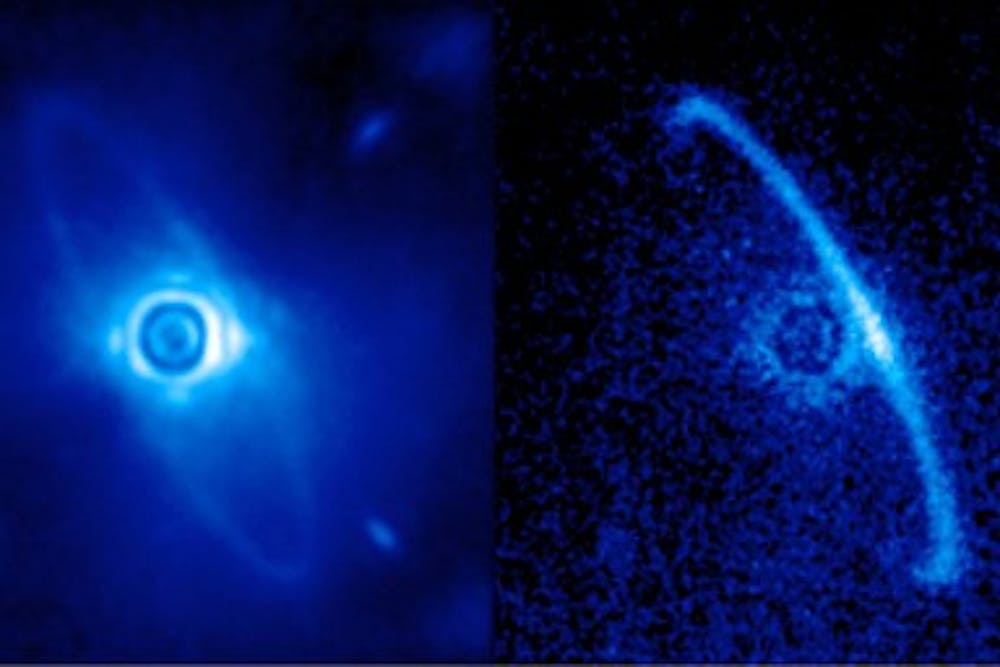 Astrophysics graduate students Kimberly Ward-Doung (left) and Abhijith Rajan (right) pose for a photograph. Doung and Rajan work on GPI under the supervision of Jennifer Patience. (Photo courtesy of Jennifer Patience)
Astrophysics graduate students Kimberly Ward-Doung (left) and Abhijith Rajan (right) pose for a photograph. Doung and Rajan work on GPI under the supervision of Jennifer Patience. (Photo courtesy of Jennifer Patience)After 10 years of intense work, the Gemini Planet Imager, the world’s most advanced instrument for direct imaging and analyzing planets around stars, collected its first data with the help of two students, a research associate and a research assistant under the supervision of Jennifer Patience, an astrophysicist and professor in the School of Earth and Space Exploration.
GPI is a planet imager and a spectrograph which allows users not only to take pictures of planets a million times fainter than nearby stars, but also probe the atmosphere and examine planet-forming discs.
The instrument detects infrared radiation from young, Jupiter-like planets in wide orbits around stars. GPI is able to study every imaged planet in great detail. The tool is the size of a small car and goes on the back of the 8-meter Gemini South Telescope mounted in Chile.
Patience started working on the instrument from scratch almost 10 years ago. She helped develop the scientific case for the instrument to try to understand what design requirements would be needed. Later, Patience made contributions from areas of the technical side and worked on the best target set to observe.
Patience came to ASU two years ago and gathered an enthusiastic team.
"We had a huge effort to go through hundreds and hundreds of stars to identify the best candidates for the system," she said. "Now students are helping with analyzing the test data that’s been coming in from November and December telescope time. We are also working on the calibration of the instrument for the upcoming planet survey."
Astrophysics graduate student Abhijith Rajan came to ASU specifically for GPI and has been working on the tool for the last five years.
“If I had gone to any other school, I might not have had a chance to work on GPI," he said. "ASU for me was GPI."
Rajan is assisting with calibration and understanding the sky background, but he said he hopes to go down to Chile and assist with actual data collecting.
“What we do is mask out the light of the star and just look for the light of the planets themselves,” he said. “When planets are young, 20 to 100 million years old, they are very hot and radiating, so in the infrared they are actually bright. If you block out the light of the star and look in the infrared, then you can actually make out these little dots.”
 Gemini Planet Imager's first light image of the light scattered by a disk of dust orbiting the young star HR 4796A. The left image shows normal light, including both the dust ring and the residual light from the central star scattered by turbulence in the Earth's atmosphere. The right image shows only polarized light. Leftover starlight is unpolarized and hence removed from this image. (Processing by Marshall Perrin, Space Telescope Science Institute)
Gemini Planet Imager's first light image of the light scattered by a disk of dust orbiting the young star HR 4796A. The left image shows normal light, including both the dust ring and the residual light from the central star scattered by turbulence in the Earth's atmosphere. The right image shows only polarized light. Leftover starlight is unpolarized and hence removed from this image. (Processing by Marshall Perrin, Space Telescope Science Institute)In this respect, GPI showed significant improvement over previous methods. For instance, NASA's Kepler can only see planets that pass in front of the star, which makes this technique more sensitive to closer orbit planets.
Radial velocity, another technique, is potentially very strong but very dependent on the system's configuration, Rajan said.
“As long as you can block out the light of the star, you can detect any planet,” he said.
The first GPI observation was aimed at previously known planetary systems, including the Beta Pictoris system. In it, GPI acquired the first spectrum of young planet Beta Pictoris b. The run showed that GPI is dramatically faster than the previous technologies.
Planet detection that used to take 40 minutes is possible in just one minute now, Rajan said.
“We’re talking about significantly faster," he said. "It’s a full generation ahead of anything that’s available right now."
Postdoctoral research associate Robert De Rosa came all the way from the U.K. to work in Patience’s team. He said having cutting-edge technology throughout the instrument helps to make it the best instrument to date, but he acknowledged that the field is very competitive.
“GPI is the first of its kind, but it’s going to be joined by other competing instruments very soon, so we have to stay one step ahead,” he said.
De Rosa received the first images from GPI when he was in a pub back in England.
“I was with my friends, and I got an email from Marshall Perrin, one of the lead GPI guys,“ he said. “The images were pretty amazing compared to what current instruments can do. It was spectacular to see them. I’ve played a small part in getting it to where it’s now, so I feel kind of proud.”
Astrophysics graduate student Kimberly Ward-Duong said the first results were really surprising and exciting. She helped with the preliminary studies by “weeding out” binary stars, which could interfere with the ability to find new planets.
“A lot of people are starting to say that direct imaging is the way the exoplanet science is going in the future,” she said. “The fact that we are able to image planets with direct techniques, get their atmosphere and composition, opens a whole new field of science and new things we can discover that were inaccessible to us before.”
Each way of searching for planets will have its own limitations, and GPI is not an exception. There are some properties, such as the size, the youth of the planets and the brightness ratio, that astronomers need to keep in mind.
However, the future for GPI looks bright, Ward-Duong said.
“Huge scientific projects like GPI take many years of planning, research and development," she said. "It's amazing to think technology similar to GPI could be used on a space-based mission in the next decade or two — maybe even one that will allow us to image an Earth-sized planet someday."
The members of the team are looking forward to new milestones. Patience said that more exciting times are yet to come in 2014 for the team.
“Right now we are in the period of testing the instrument, making sure the performance is what we had designed and expected," she said. "In the fall, we’ll initiate a three-year planet-search campaign. We just have to do our final, last selection to get the best 600 stars that will be surveyed. That should give some really nice statistics and lots of room for new discoveries.”
Reach the reporter at kmaryaso@asu.edu or follow her on Twitter @KseniaMaryasova




